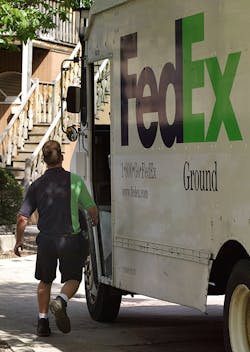What can be learned from FedEx Ground’s independent contractor model
The Ninth Circuit Court of Appeal yesterday said that FedEx Ground’s classification of some 2,300 employees as independent contractors is wrong. The court ruled, in a case that covers employees in California from 2000 through 2007, that these contractors were in fact employees of FedEx Ground and the company may now be liable for millions of dollars in restitution for these drivers, most of whom have paid out of pocket for items such as uniforms, fuel, insurance, tires, oil changes, maintenance and even the FedEx Ground trucks they drive, said the law firm of Leonard Carder, which handled the case on behalf of the drivers.
The complete ruling can be found at leonardcarder.com.
According to the law firm, the judge writing the majority opinion found that the “plaintiffs are employees as a matter of law under California’s right-to-control test.”
The law firm said the impact of the ruling could cause a trickle-down effect on as many as two dozen similar cases nationwide in which FedEx Ground drivers are challenging their status as independent contractors. It also could shake the foundation of the independent contractor model used throughout the trucking industry.
“FedEx Ground built its business on the backs of individuals it labelled as independent contractors, promising them the entrepreneurial American Dream,” said Leonard Carder Attorney Beth A. Ross. “However, as Judge Trott said in his concurring opinion, not all that glitters is gold.”
The law firm laid out some specifics of what it said is FedEx Ground’s business model, including that in some cases, workers were required to pay the wages of employees who FedEx Ground required them to hire to cover for them if they were sick or needed a vacation. Also, the firm said, the “contractors” worked at the “whims of FedEx management and FedEx Ground’s decisions on staffing and routes left the employee drivers stuck with expensive long-term truck leases on FedEx branded trucks.”
“Nationally, thousands of FedEx Ground drivers must pay for the privilege of working for FedEx 55 hours a week, 52 weeks a year. Today, these workers were granted rights and benefits entitled to employees under California law. To be clear, the Ninth Circuit exposed FedEx Ground’s independent contractor model as unlawful,” said Ross.
One of the underlying issues at work here, of course, is pay and benefits. Just a few short years ago, another FedEx Corp. company, FedEx Express, was embroiled in a tough battle with rival UPS and the Teamsters over the classification of its drivers. Express drivers are currently classified under the FAA, which UPS and the Teamsters wished to change. Those entities lobbied members of Congress when the FAA Reauthorization Act of 2009 came up for debate to get wording included in the bill that would put Express drivers under the jurisdiction of the National Labor Relations Act, under which UPS drivers are covered.
Doing this would have made it easier for the drivers to unionize, thereby raising costs for FedEx Express. It’s obviously why both UPS and the Teamsters would support such a decision.
FedEx spent millions fighting that – even creating a nickname for the efforts, dubbed Brown Bailout, and a special website - and eventually got the wording removed.
Here’s a video that appeared on Brownbailout.com putting the fight in context (at least from Federal Express’ viewpoint).
There is no doubt that FedEx Ground has built a successful business model, but is it one that will last? And, in a broader sense, are businesses that rely on the independent contractor model to conduct their operations in danger as well?
There is a website, Nolo Law for All, that devotes a section to independent contractors. It lays out some of laws and explains how the government tries to classify workers. There are plenty of federal agencies that must weigh in, but it notes that the IRS is perhaps the most important. According to the site, here are the steps the IRS uses to help classify a worker as an independent contractor.
Can the worker:
- an earn a profit or suffer a loss from the activity
- furnishes the tools and materials needed to do the work
- is paid by the job
- works for more than one company at a time
- invests in equipment and facilities
- pays his or her own business and traveling expenses
- hires and pays assistants, and
- sets his or her own working hours.
On the other hand, a worker may be an employee if they:
- can be fired at any time
- are paid by the hour
- receive instructions from the company
- receive training from the company
- work full time for the company
- receive employee benefits
- have the right to quit without incurring liability, and
- provide services that are an integral part of the company’s day-to-day operations.
As you can see, there is no obvious answer to this question. What the site does say is that even if you and the employee agree to an independent contractor relationship, that does not make it so.
It’s good advice, if you run with an independent contractor model, to ensure those drivers are truly independent contractors and not employees.
FedEx Ground may be about to learn that the hard way.


